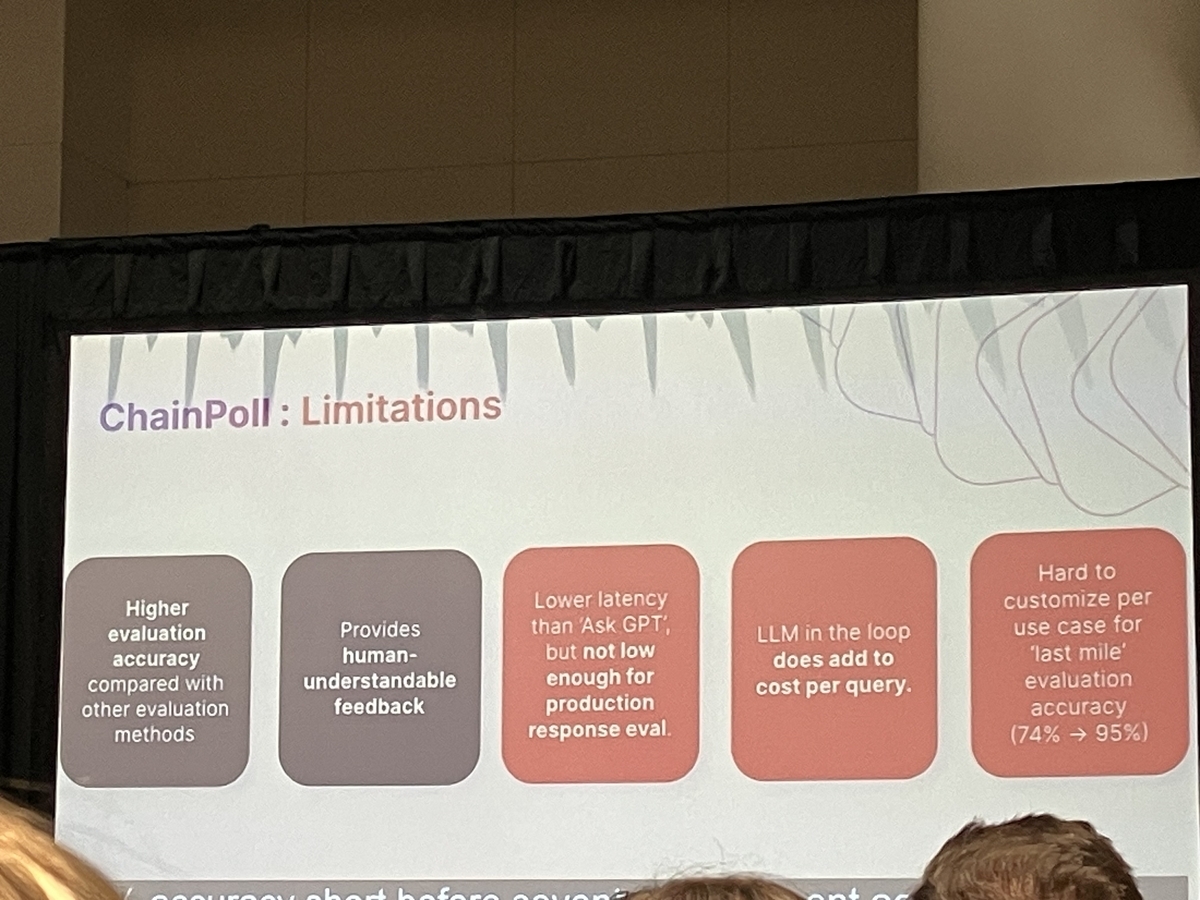
Preface
In the realm of LLMs, mitigating the risk of hallucination and ensuring the accuracy of outputs is fundamental. This section details the inherent challenges during the human evaluation phase of model development and deployment. Understanding these challenges is crucial for devising effective strategies to enhance the reliability and efficacy of LLMs.
- Preface
- Innovative Evaluation Techniques
- Advanced Module Implementation
- Scalable Solutions and Practical Applications
- Real-time Evaluation and Security
- Summary
- About the special site during DAIS
The phenomenon known as "hallucination" refers to instances in which large language models (LLMs) generate inaccurate or unrealistic text. Identifying and mitigating these occurrences is essential for deploying LLMs in a reliable manner. However, many development teams rush to production without adequately addressing this issue, increasing the risk of deploying insufficiently validated models.
Opacity in Evaluation Metrics
Evaluations of LLMs often encounter issues with delayed or ignored responses using review tools. For instance, a rating of "5 out of 5 stars" often lacks clarity. What does this rating imply about the model's performance? Are there context-specific issues that influenced this score? The lack of detailed explanation and the opaque logic behind such evaluations make verifying the actual quality of model output difficult.
Differences in Human Values
When individuals from different cultural backgrounds use the same tools or services, differences in human values can emerge. This variability is prevalent in LLM development and can lead to inconsistency and bias in training and evaluation methods. Recognizing these differences is crucial in creating balanced and fair models that serve a broad user base.
Innovative Evaluation Techniques
This session focused on the frequently occurring "hallucination" in large language models (LLMs)—the phenomenon where models produce inaccurate or unrealistic text. A critical aspect of this discussion was the development and application of methodologies to effectively identify and mitigate these errors.
A significant innovation in evaluation introduced during the session was the "ensemble" approach. Unlike traditional methods where model performance is evaluated based on a single output, the ensemble method generates multiple responses to the same query from the model. This approach aims to improve the consistency and reliability of model outputs by comparing and analyzing the diversity of the generated responses.
Transitioning from traditional single evaluations to ensemble techniques addresses several shortcomings:
- It improves directional evaluations, aligning evaluations more closely with real-world expectations of model behavior.
- It reduces variations in results for similar queries, enhancing model reliability.
- It assesses the spectrum of model responses to the same query, providing a normalized measure of performance.
Through multiple demonstrations and comparative analyses during the session, participants gained a deeper understanding of the benefits of adopting ensemble techniques. This method not only provides more robust evaluations but also significantly reduces performance metric variability, leading to more reliable practical applications of LLMs.
This innovative approach is fundamental in ensuring the quality and applicability of LLMs in real-world scenarios. Adopting rigorous and comprehensive evaluation techniques can pave the way for deploying more reliable and efficient language models across various domains.
Advanced Module Implementation
In this session, significant attention was paid to the implementation of advanced modules, particularly focusing on a key component known as the "Martina Park Module." This session provided comprehensive insights into its setup and functionalities.
Role of the Martina Park Module
Essential to the system, the Martina Park Module functions as a critical element by integrating data from logs, prompts, and model responses to perform non-linear interpretations that lead to the generation of final scores. This module's capability to deeply analyze and interpret data is extremely valuable and dramatically reduces error rates in large language models (LLMs).
Integration with Lower-Level Models
The system utilizes the capabilities of an advanced model named "Da Vinci." While this is an advanced model, its optimal functioning significantly relies on robust support from the Martina Park Module. This synergy is particularly vital during the cleanup and optimization phases, ensuring efficient performance of the system.
System Optimization and Cleanup Process
The final stages of refinement involve a thorough cleanup and optimization where seamless interaction among each component is crucial. The Martina Park Module plays a significant role in this stage, greatly impacting the overall efficiency and performance enhancement of the system.
Through detailed discussions during the session, the functionalities of the Martina Park Module were elucidated, along with its critical impact on the selection and implementation of advanced LLM models. As technology continues to evolve, there is a heightened expectation for more sophisticated module implementations, promising improved operational efficiency in future deployments.
Scalable Solutions and Practical Applications
The discussion focused on mitigating hallucination risks in large language models (LLMs) explored several scalable and practical solutions:
Utilization of Compact Language Models:
- The application of smaller language models has proven effective in detecting hallucinations. This approach optimizes the balance between model size and response speed, demonstrating practicality in real-time environments.
Implementation of Pre-paging and Alignment Models:
- Adopting pre-paging and alignment models significantly enhances the accuracy of hallucination detection. These models leverage the structural system of specific dialogue systems to establish the relationship between context and responses, providing more accurate outcomes.
Application of Binary Response Techniques:
- The session highlighted the use of binary response techniques where the model evaluates hypotheses as true or false. This method offers a scalable option for reliable hallucination detection across various LLM applications.
Through specific demonstrations, the functionality of each method in combating hallucinations was effectively showcased. Insights on these approaches not only facilitated an understanding of operational mechanisms but also outlined challenges encountered in real-world scenarios. This segment captures the essence of practical and scalable solutions necessary for reliable LLM deployment.
Real-time Evaluation and Security
Recent developments in the Gallaudet Project have highlighted the importance of real-time evaluation and security, driven by corporate client demands. This breakthrough primarily involves detecting and correcting erroneous outputs before reaching end-users, significantly enhancing overall reliability and trust in LLM technology.
Originally, the ability to exclude inaccurate or undesirable outputs in real-time was challenging due to substantial cost considerations and technical agility. Conventional approaches were unable to meet these stringent requirements without compromise.
However, the introduction of a new method similar to the established "TrackCard" technology has facilitated a paradigm shift. Advances in this technology not only secure outputs in real-time evaluation but also significantly reduce associated costs, solving previously insurmountable issues.
This section highlights the importance of these improvements in enhancing the real-time evaluation and security modules of LLM applications. Such systems are essential in preventing hallucinations and nonsensical content generation while strictly adhering to the data integrity standards expected by enterprise users.
Summary
This final section emphasized key strategies and innovations to enhance security and improve real-time evaluation of LLM outputs. The discussed advancements deter undesirable hallucinations and ensure deployments are reliable and trustworthy. As these technologies continue to evolve, focusing on robust real-time security measures and error prevention will be crucial for broad applications across industries.

About the special site during DAIS
This year, we have prepared a special site to report on the session contents and the situation from the DAIS site! We plan to update the blog every day during DAIS, so please take a look.